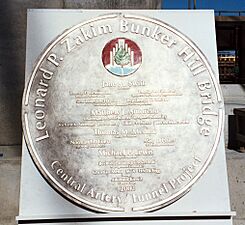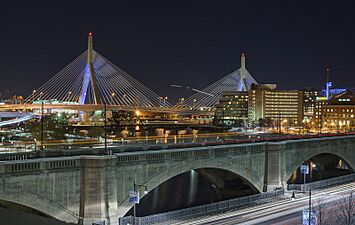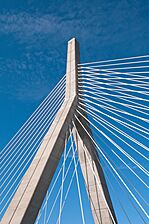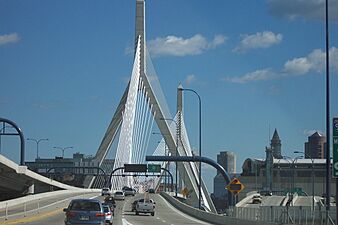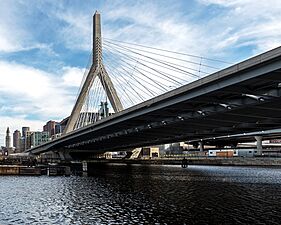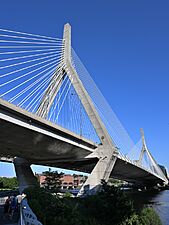Leonard P. Zakim Bunker Hill Memorial Bridge facts for kids
Quick facts for kids Zakim Bunker Hill Bridge |
|
|---|---|

Leonard P. Zakim Bridge, alongside the Leverett Circle Connector Bridge, 2017
|
|
| Coordinates | 42°22′08″N 71°03′48″W / 42.36889°N 71.06333°W |
| Carries | 10 lanes of |
| Crosses | Charles River, MBTA Orange Line |
| Locale | Boston, Massachusetts (North End–Charlestown) |
| Official name | Leonard P. Zakim Bunker Hill Memorial Bridge |
| Owner | Commonwealth of Massachusetts |
| Maintained by | Massachusetts Department of Transportation |
| Characteristics | |
| Design | Cable-stayed bridge |
| Material | Steel, prestressed concrete |
| Total length | 1,432 ft (436 m) |
| Width | 183 ft (56 m) |
| Height | 270 ft (82 m) |
| Longest span | 745 ft (227 m) |
| Clearance below | 40 ft (12 m) |
| History | |
| Construction cost | $105 million |
| Opened | March 30, 2003 (northbound) December 20, 2003 (southbound) |
The Leonard P. Zakim Bunker Hill Memorial Bridge is a super cool bridge in Boston, Massachusetts. It crosses the Charles River and was finished in 2003. People often call it the "Zakim Bridge" or "Bunker Hill Bridge".
This bridge is a special type called a cable-stayed bridge. This means its road deck is held up by strong cables connected to tall towers. It replaced an older bridge from the 1950s.
The Zakim Bridge was a big part of the Big Dig. This was a huge project to build new highways and tunnels in Boston. The bridge's unique shape quickly became a symbol for Boston. You might see it in the background of TV shows or on souvenirs.
Another bridge, the Leverett Circle Connector Bridge, was built at the same time. It helps some cars get around the Zakim Bridge.
Contents
How the Bridge Looks
The Zakim Bridge was designed by a Swiss engineer named Christian Menn. He worked with bridge designer Miguel Rosales. They created a unique look for the bridge.
It's a cable-stayed bridge with a "harp" design. This means the cables look like strings on a harp. The main part of the bridge carries ten lanes of traffic. These lanes are for Interstate 93 and U.S. Route 1.
Underneath the bridge, there's a tunnel for the MBTA Orange Line. This is Boston's subway system.
Why the Name?
The bridge has a long name to honor two important things. It remembers Leonard P. Zakim, a leader from Boston. He worked hard for civil rights and believed in "building bridges between peoples."
The name also honors the Battle of Bunker Hill. This was a famous battle during the American Revolutionary War. It happened nearby in Charlestown.
The bridge was officially opened on October 4, 2002. There was a special ceremony on the new bridge. Leonard Zakim's family and government leaders spoke. Even the famous singer Bruce Springsteen performed a song.
Art and Nature Around the Bridge
Building the Zakim Bridge changed the shape of the Charles River shoreline. This allowed for new public spaces under the bridge. These areas were designed by Carol R. Johnson Associates.
Under the bridge, you can see cool public artworks. They are called Five Beacons for the Lost Half Mile. These artworks use special lights.
People can walk or bike from Charlestown to Cambridge. They use the nearby North Bank Bridge. This bridge connects to North Point Park. It's also part of the Charles River Bike Path and the East Coast Greenway.
Images for kids
-
The bridge and the northern part of the Rose Fitzgerald Kennedy Greenway.
See Also
- List of crossings of the Charles River


